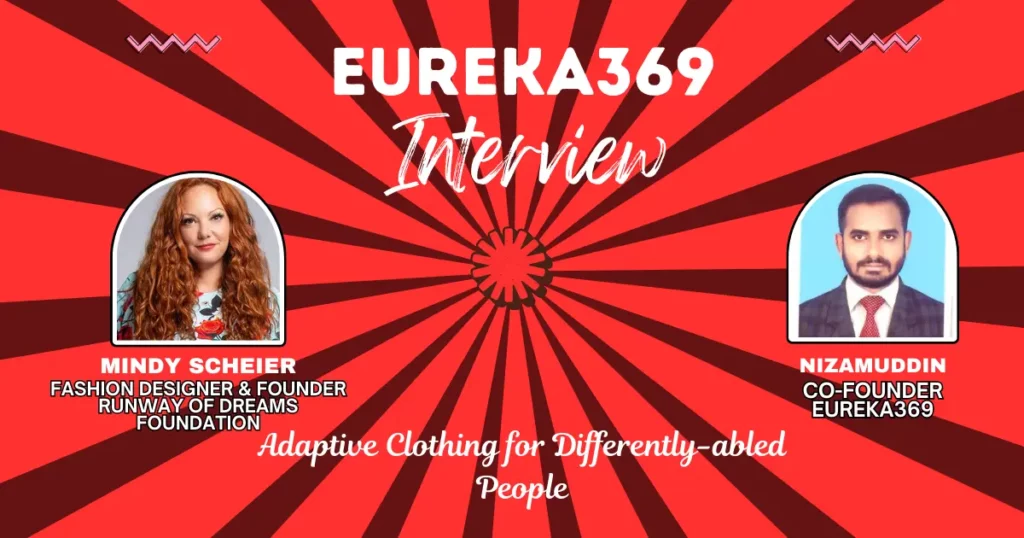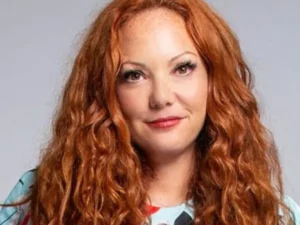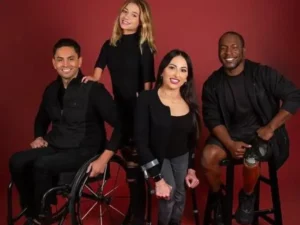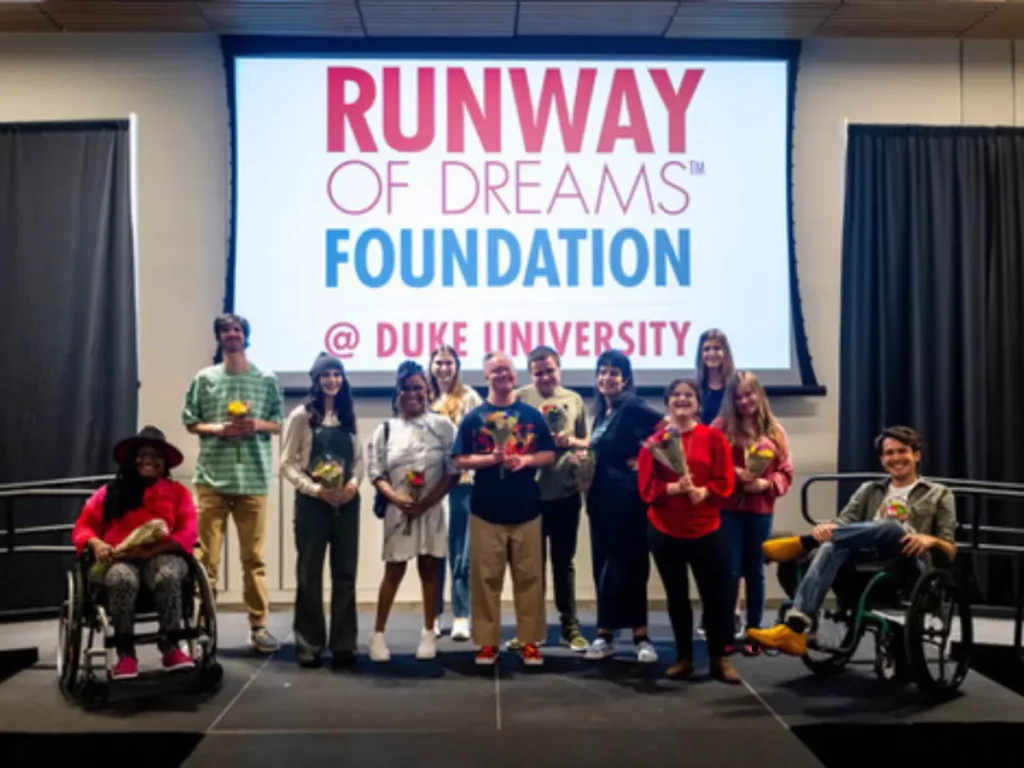
Founder of Runway of Dreams Foundation,
Picture Source: CanvaPro
The Unmet Need: Fashion for All Abilities
One fine day, I was doing research on sustainability in the fashion industry. I was planning to write a blog on adaptive clothing for people with disabilities. I was going through different fashion designers, and there were a plethora of stories about differently abled people with their struggles and motivations. How they manage their daily lives and struggle to even put on their clothes. Many of them put forth a significant amount of effort.
Then, I came across this TedTalk on adaptive clothing for people with disabilities. In that talk, a woman shared her personal story about her son. Who is a differently abled person? However, he also wants to wear trendy clothes. She was Mindy Scheier, founder of the “Runway of Dreams Foundation.”
As a fashion designer, she realized this need not only for her own son but also for millions of people around the world. She deeply felt that when it comes to outfits for differently abled people, fashion trends or style are often overlooked. There is no significant work done for such a clothing line, where clothes could be designed to not only fulfill their specific needs but also maintain style and the latest fashion trends. You can also watch her small talk on How adaptive clothing empowers people with disabilities or watch below:
The Intersection of Sustainability and Adaptive Clothing
However, in today’s fashion landscape, inclusivity and sustainability are increasingly entwining, especially for differently abled individuals. Sustainable clothing is not just about eco-friendly materials; it also encompasses the need for adaptive designs that cater to diverse physical needs. Since sustainable fashion goes beyond merely using organic fabrics or reducing waste, it also emphasizes the importance of creating clothing that is functional and adaptable for those with disabilities.
Adaptive clothing incorporates features such as magnetic closures, adjustable waistbands, and designs that facilitate simple dressing, allowing individuals with various physical challenges to dress independently. This approach not only enhances the quality of life for differently abled individuals but also empowers them to express their identities through fashion.
Mindy Scheier, a trailblazer in this realm, has dedicated her career to ensuring that fashion is accessible to everyone, regardless of their abilities. Her work highlights the importance of creating clothing that allows individuals with disabilities to express their identities and feel confident in their appearance.
Therefore, I decided to interview her in order to get more insights about the fashion clothing line for differently abled people. Because every differently abled person has different needs, they require customized outfits. I wanted to ask her about the challenges she faced when designing those outfits, while still maintaining her creativity and style. There were various other questions in my mind, which I was eager to ask.
Finally, I had the opportunity to interview her, and she graciously gave me thirty minutes out of her busy schedule. I was truly excited to learn more about her initiatives, experiences, and impact. I am glad that I got this opportunity and tried to cover as many aspects of adaptive clothing for differently abled persons as possible during the interview.
I really appreciate that she answered all my questions in such great detail. This is definitely an inspiration for all of us. She confronted her son’s predicament, saw it as a challenge, and turned it into a chance.
Meet Mindy Scheier: The Visionary behind Adaptive Fashion

She is the founder of the Runway of Dreams Foundation and a pioneer in adaptive clothing. Her journey began when her son, Oliver, expressed his desire to wear jeans like his peers, highlighting the significant gap in fashionable clothing options for those with unique needs. Mindy’s work has not only reshaped the fashion landscape but has also sparked important conversations about inclusivity and representation in the industry.
Fashion Forward: Mindy Scheier Addresses Key Questions
Nizamuddin: Thank you for joining us today, Mindy. I understand that a pivotal moment for you was a conversation with your son, Oliver, who expressed a desire to wear jeans like his friends. Can you share more about that moment, and how did that realization shape your long-term vision for the foundation and the adaptive fashion movement as a whole? What did that experience teach you about the importance of inclusivity in fashion?”
Mindy Scheier: So when Oliver was of school age, we had to really think about what he was going to wear to school so that we knew he’d be able to go to the bathroom on his own. He would be able to wear his leg braces comfortably, among other things.
So he wore sweatpants every single day until he was eight years old and came home from school and said, Mom, I want to wear jeans like everybody else gets to wear, and it was a true pivotal moment, not only as a mom but also somebody that dedicated her career to the fashion industry, that I needed my eight-year-old to remind me of how important clothing is to who you are as a person. How you show up to this world, and Oliver was expressing that just because he had a disability didn’t mean he had to dress like he had a disability, and he wanted to be able to wear the same things as everyone else.
So that night, I ripped apart a pair of his jeans and put them back together with some Velcro and creative stitching and a way that would allow him to independently dress himself but still wear the same jeans that everybody else was wearing at the time.
He really wanted to wear Levi’s when it was the first time that next day, when he dressed himself independently for the first time ever, with anything that had buttons or zippers in it, it was a prolific moment in his life and in my life, that if a simple pair of jeans, changed so profoundly how Oliver viewed himself and how he felt that he was showing up to the world.
I couldn’t believe how the 1.8 billion people on our planet were managing clothing challenges and how it must have affected their everyday life, as it did Oliver. So this was back in 2013 and I decided to take my background and have a small, little, tiny goal, say that, very sarcastically, of changing the fashion industry and Runway of Dreams is born.
Nizamuddin: What are some of the most common misconceptions about designing adaptive clothing? How do you address these challenges in your work?
Mindy Scheier: I would say the greatest misconception a couple of things. I think, first and foremost, there’s a lot of misnomers about who the population of people with disabilities are in terms of the size and scope.
I was told many times in the beginning that, oh, it’s a niche population. You know, people with disabilities don’t really care how they look, or are not going to spend money on clothing, etc., All of which are completely untrue, as people with disabilities make up the largest minority in the world, and it’s the only minority that every single one of us could be a part of at any point in our life, and there’s an estimated $13 trillion that’s being left on the table every year by not including people with disabilities into our mainstream conversation, and particularly in the fashion and beauty industry.
The second aspect, when you first understand how big the population is, I think then it became very daunting to brands that, how could they possibly create something that was going to help so many different types of people, so many different types of disabilities, etc.
When we looked at it from the perspective of what modifications could be made to existing product to make it easier for more people to be able to wear so I did a year’s worth of research, including surveys, focus groups, talking to doctors, physical therapists, occupational therapists, etc. And really honed in on what these modifications could be, and it really came down to three categories.
The first was the notion of closure. So button snap, zippers, hook and eyes are a very big challenge across many different types of disabilities, including cognitive and physical. So thinking about other forms of closures, such as Velcro or magnets, makes it so much easier for people to wear the product.
The second is having the product be adjustable. So pant lengths, sleeve lengths, waistbands. Having that capability of adjusting the product to fit different shaped bodies was also another way.
And the third way was really rethinking the way that a product goes on to the body. So putting something over your head or arms through the armholes, head through the neck holes, if you have low muscle tone, if you are missing digits or limbs, or if you had to be dressed 100% of the time, that’s a very difficult process. So opening up the product, for example, your T shirt in the back and going in through the arms first and have it closed in the back is a much easier way to be able to support those that are not able to dress themselves in the typical way.

Source: www.runwayofdreams.org
Nizamuddin: How do you incorporate feedback from the differently abled community into your design process? Could you provide an instance where consumer input directly impacted a design change?
Mindy Scheier: Yes. So first of all, I want to just explain that I started then a second company in 2019 by the name of gamut Management. Gamut is a consulting and talent community exclusively working in the adaptive space. So we only represent people with disabilities, and we only work with brands on helping them get into the adaptive space.
So when we talk about how the modifications are developed or the whole process of getting into the adaptive space, we include people with disabilities at every step of the value chain, because it is truly impossible to design market. Do PR for advertise etc. People with disabilities without having their voices included. It’s an essential part of the whole process. So that is something that Gam is strongly diligent to, that we really have people with disabilities involved at every step of the process.
Nizamuddin: Collaborating with major brands like Tommy Hilfiger is a significant achievement. What strategies do you use to convince traditional fashion brands to embrace adaptive design?
Mindy Scheier: Since, our partnership with Tommy back in 2016, they were the first mainstream brand to get into the adaptive space. I’m happy to say that the pendulum have has shifted a bit in that now, because there are many more brands in the adaptive space, like Target and Coles and JCPenney, Victoria’s Secret Neiman Marcus, etc.
It is a less difficult, somewhat still difficult, but less difficult conversation to explain to brands why inclusion of people with disabilities into their products is so important, because now there’re so many brands that are ready in the space that I can point to and say, well, they’re doing it, and there’s a reason why they’re doing it, because they understood that they were missing out on a big part of the population, and having the case studies that we do now does help facilitate that conversation a little bit easier.
Nizamuddin: What do you think Artificial intelligence can impact adaptive designs and the entire fashion industry and do you believe in incorporating the technology with the sustainable craftsmanship?
Mindy Scheier: I am actually a very big believer in the fact that technology plus design equals adaptive. So I think that we have incredible tools at our fingertip, including AI, that can really help with the development and newer ideas, perhaps, of you know, ways to modify products and or what is, you know, meeting the needs of people With Disabilities, and maybe what isn’t I think the key is that even with AI data from people with disabilities, needs to be included into the AI universe. As these can’t be assumptions, so to speak. I think that it needs, even from an artificial intelligence perspective, people with disabilities need to be woven into that some way, somehow,
Nizamuddin: What, in your opinion, are the emerging trends in adaptive fashion that you believe will shape the industry’s future? How can brands stay ahead of these trends?
Mindy Scheier: I think it’s really, really important for brands to begin to get educated on who this population is. As statistics are really showing that with every demographic there and upcoming generations, there’s a 20% increase in the amount of disabilities now.
Is that because we are putting a name to something that we didn’t know what it was 20 years ago, maybe. But regardless, there are some theories out there that there could be a time that there’re more people with disabilities on the planet than not.
So when you think about it from that perspective, this is a trend that’s only going up. So including this population now, and really getting a good understanding of who they are and how to meet the needs is critically important to being able to support all, a full customer base, and it’s something that you know, education is no question the first place to start, and that’s a big part of what we Do at gamut, is to help support education programs, workshops, panels with people with disabilities, etc.
Nizamuddin: How do you think adaptive fashion can change societal perceptions of disability? What role does fashion play in promoting inclusivity beyond clothing?
Mindy Scheier: Well, I think there’s a lot of merit to the notion of if you don’t see it, you can’t dream it. And I think having people with disabilities embedded into our mainstream world.
One very important way of that is the fashion industry, and what we are seeing on billboards and seeing in magazines and on commercials and advertisements, etc. increasing the amount of people with disabilities we’re seeing as part of our mainstream world only leans into normalizing that people with disabilities come in All different shapes, sizes and abilities.
Nizamuddin: What initiatives or campaigns have you found most effective in raising awareness about the importance of adaptive clothing? How can individuals support this cause?

Mindy Scheier: So I think brands like I’m going to use Victoria’s Secret as an example, have really gotten into the adaptive space in the most authentic way. Not only did they include over 200 women with all different disabilities, ethnicities, ages into the development of the product.
They then carried on through, you know, marketing campaigns, social media, influencing campaigns, all the way up to being on the Runway of Dreams, runway. And I think threading that notion that people that, in this case, women with disabilities, were at the forefront of every part of the creation and marketing of this product really leaned into the authenticity and how well a brand can do by extending into this new category, and again, including people with disabilities.
I absolutely encourage people always to everything starts with the conversation in your workplace, in your communities. Start talking about, what would life be like for you if you were unable to dress yourself tomorrow morning. If you had nothing in your closet that you could wear that was appropriate to whatever you were doing that day because you actually could not dress yourself.
The fact that you Don’t see anyone with a disability in a magazine or a billboard or etc., how would that make you feel? And I think starting with those conversations and asking the more difficult questions to you in your companies to say, how are we including people with disabilities in this conversation? How, how are we considering them as consumers? Those are the conversations that start to make change happen. Okay?
Nizamuddin: As a leader in adaptive fashion, how has your personal journey influenced your leadership style and decision-making? What lessons have you learned along the way?
Mindy Scheier: I would say, you know, I’m in a very interesting position that this is personal and professional to me, so that definitely gives a different edge in my leadership style, because every step forward that we make is a step that is more than there was yesterday.
So I feel like I have an innate sense of no matter what, no matter how difficult the day is, or roadblocks that we hit, or walls that go up. I don’t have the luxury of saying, all right, I think I’m done. I’ve had enough. It’s too difficult, etc, because I want to create a world that’s better for my own son. So it definitely helps. I think, in my leadership style, that I am always getting up the next day after, you know.
Nizamuddin: Can you explain the vision behind Gamut Management and how it complements the mission of Runway of Dreams? What impact do you hope it will have on the representation of differently abled individuals in fashion?
Mindy Scheier: So the creation of gamut management came very organically. As after our partnership with Tommy went live, we received a huge amount of incoming requests from so many brands, even other industries, primarily the entertainment industry, asking how they can get connected to people with disabilities, etc.
So it became very clear that a second company, a for profit company, needed to be born, and that was gamut management in 2019 to really help support and work side by side with these companies and include people with disabilities into every step in order to help these brands and either productions or advertising companies really work with and for People with disabilities.
So gamut really serves as that external support system to provide for brands to get into the adaptive space. So as we like to say, Runway of Dreams is the ‘why’, and gamut is the ‘how’.
Nizamuddin: Looking ahead, what legacy do you hope to leave in the fashion industry? How do you envision the future of adaptive fashion in the next decade and where do you see yourself?
Mindy Scheier: Well, to be honest, I do really hope that we don’t even need to have these conversations anymore in within the next 10 years, because it is just a part of our mainstream world.
Adaptive is just a category in the fashion industry, and that people with disabilities are just consumers. That is certainly my goal, I always like to say is to put myself out of business, truly.
That is not a need any more for this big movement, and that would be a really lovely, lovely day. But I would love my legacy to be that we really succeeded and made this change happen and that again, you know. People with disabilities are just consumers and a part of our mainstream world.
Nizamuddin: Thank you, Mindy, for sharing your incredible insights and experiences with us today. The discussion about adaptive fashion and the significant impact of “Runway of Dreams” is truly inspiring. It’s remarkable to see how a simple request from your son, Oliver, has evolved into a movement that empowers countless differently abled individuals, making fashion more inclusive and accessible. Thank you. Thanks a lot.
Mindy Scheier: Thank you.
Final Thought
We hope you found this conversation as enlightening and inspiring as we did. Mindy’s work is a powerful reminder of the change we can create when we listen to the needs of others and advocate for inclusivity in all aspects of life.
Her journey from a personal challenge to a movement that empowers countless individuals with disabilities is truly inspiring. By advocating for inclusive and sustainable clothing, she is not only changing the fashion industry but also fostering a more accepting society. As we look to the future, it is essential to continue these conversations and support initiatives that promote inclusivity for all.
If you are interested in supporting adaptive fashion, consider checking out the Runway of Dreams Foundation and Gamut Management. Together, we can help ensure that fashion is a space for everyone. Thank you for reading. Take care!”
Also check out Sustainable Craftmanship and Technology: Fashion’s Future



